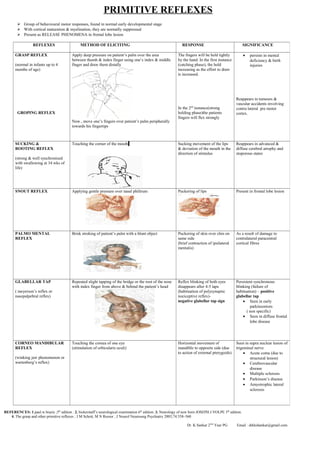
Primitive reflexes
- 1. PRIMITIVE REFLEXES Group of behavioural motor responses, found in normal early developmental stage With cortical maturation & myelination, they are normally suppressed Present as RELEASE PHENOMENA in frontal lobe lesion REFERENCES: 1.paul.w.brazis ;5th edition . 2. bickerstaff’s neurological examination 6th edition. 3. Neurology of new born JOSEPH.J.VOLPE 5th edition. 4. The grasp and other primitive reflexes ; J M Schott, M N Rossor ; J Neurol Neurosurg Psychiatry 2003;74:558–560 Dr. K.Sankar 2ND Year PG Email : drkkshankar@gmail.com. REFLEXES METHOD OF ELICITING RESPONSE SIGNIFICANCE GRASP REFLEX (normal in infants up to 4 months of age) GROPING REFLEX Apply deep pressure on patient’s palm over the area between thumb & index finger using one’s index & middle finger and draw them distally Now , move one’s fingers over patient’s palm peripherally towards his fingertips The fingers will be held tightly by the hand. In the first instance (catching phase), the hold increasing as the effort to draw is increased. In the 2nd instance(strong holding phase)the patients fingers will flex strongly • persists in mental deficiency & birth injuries Reappears in tumours & vascular accidents involving contra lateral pre motor cortex. SUCKING & ROOTING REFLEX (strong & well synchronised with swallowing at 34 wks of life) Touching the corner of the mouth Sucking movement of the lips & deviation of the mouth in the direction of stimulus Reappears in advanced & diffuse cerebral atrophy and stuporous states SNOUT REFLEX Applying gentle pressure over nasal philtrum Puckering of lips Present in frontal lobe lesion PALMO MENTAL REFLEX Brisk stroking of patient’s palm with a blunt object Puckering of skin over chin on same side (brief contraction of ipsilateral mentalis) As a result of damage to contralateral paracentral cortical fibres GLABELLAR TAP ( meyerson’s reflex or nasopalpebral reflex) Repeated slight tapping of the bridge or the root of the nose with index finger from above & behind the patient’s head Reflex blinking of both eyes disappears after 4-5 taps (habituation of polysynaptic nociceptive reflex)- negative glabellar tap sign Persistent synchronous blinking (failure of habituation) – positive glabellar tap • Seen in early parkinsonism ( non specific) • Seen in diffuse frontal lobe disease CORNEO MANDIBULAR REFLEX (winking jaw phenomenon or wartenberg’s reflex) Touching the cornea of one eye (stimulation of orbicularis oculi) Horizontal movement of mandible to opposite side (due to action of external pterygoids) Seen in supra nuclear lesion of trigeminal nerve • Acute coma (due to structural lesion) • Cerebrovascular disease • Multiple sclerosis • Parkinson’s disease • Amyotrophic lateral sclerosis
